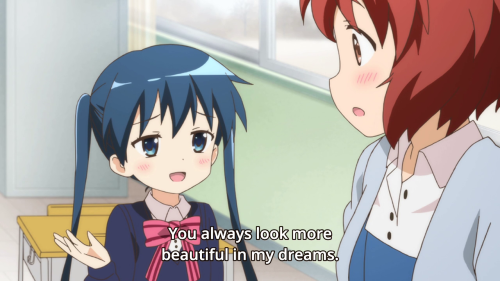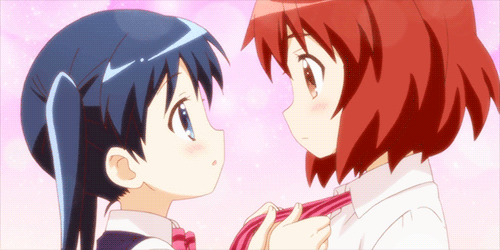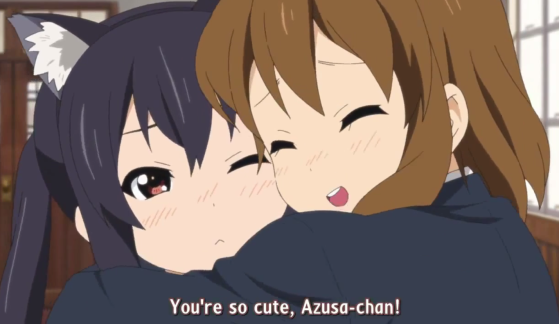Fans of the anime “Lucky Star” weaved short clips together into something incredibly cute~
I got into anime a little later than my little sister did, and when I showed her what anime series I liked, she looked at one and told me she doesn’t watch 萌え (moe/ “mo-eh”). This left me wondering what 萌え is, and should I be concerned that I’m watching 萌え?

What my sister said was not 100% true, because she adores anime like Lucky Star and Nichijou too – which, to me, has similar art-style to the “萌え” anime that she pointed out. So then, it appears to me the term 萌え is nuanced and its definition un-absolute.
The Japanese often borrow loan words from other languages to create their own terms. “Don’t mind” is coined “donmai”; wife is coined “waifu,” just to list a few. But not all Japanese words are that straight-forward. One would often stumble upon arcane slang that have a subtle spectrum of connotations. One such word is “萌え,” a term frequently used in the anime community. The kanji character by itself is only a phonetic placement – the origin of the term is unclear.

What caught my attention is the various reputations 萌え gained as the anime community grows into the 21st century. A dictionary or urban definition is far from conveying the entire scope and nuanced connotation of 萌え. Ergo, a detail enumerated illustration of 萌え is invaluable.
1. To start out simply, the main focus of 萌え is aesthetics: pleasant eye-candy that elicit feelings of 萌え and warmth, as well as vivacious or soothing voices that bring an atmosphere of endearment, comfort, delight, or even excitement. It can be expressed in a delicate, youthful way, in an energetic way, or in an under-the-surface, allusive way (see: tsundere).

2. 萌え is NOT a genre. If the genres of anime are like the various selection of entrées, then 萌え would be a specific flavor, for example, sweetness. Saying “I don’t watch 萌え” is akin to something like “I don’t eat sweet food” – and that’s completely fine – but that doesn’t make non-sweet food eaters any more superior or refined than sweet-food eaters. We all have different tastes. Continuing the analogy, a 萌え kind of art-style would be a specific way of how one prepares the dish – sautéed, simmered, steamed, etc.
3. Moments of chagrin can be 萌え. In fact, 萌え is usually more effectively expressed through action rather than inaction. For example, Tsukasa Hiiragi from the iconic anime “Lucky Star” has cute emotional reactions when placed in various social situations with her circle of close friends – whether it be surprised, beaming, or flustered. Tsukasa’s oblivious and shy nature is brought out in dynamic settings, seen through her reactions and gestures that demand notice from the viewers. It’s easy to describe Tsukasa as “gentle, quiet, and innocent” by looking at a picture of her. If seeing her in character interactions, however, the description 萌え is even more evident.

4. 萌え is not just affection. 萌え lightens up the viewer’s day no matter what mood he or she is in. Feelings of 萌え also evoke a sense of solicitude, i.e., a character whom one has a strong desire to protect. A casual fan of 萌え anime would most likely be elated to receive a character figurine as a gift.

Let us give an example of how 萌え characters are portrayed.
Alice Cartalet (from Kiniro Mosaic) is a dainty, blonde girl born in England who later became fascinated with Japanese culture after a student named Shino homestayed in her house. She is shorter than the rest of her friends, giving her a grade-school like appearance. Her hair is tied in pigtails and decorated with ornament hairsticks, a gift from Shino. Her school uniform has a rose-colored ribbon below the collar, and she wears a short pleated skirt with thigh-high white socks.
5. 萌え is most commonly found in slice-of-life anime, partly because it is easy to incorporate 萌え into that genre. “Kiniro Mosaic,” with its bubbly animation and heart-warming character dynamics, is a classic 萌え anime. “Lucky Star,” with its witty references and adorable character interactions, uses 萌え to great effect and success. “Nichijou,” which conveniently translates to “everyday life,” is another interesting example. Incredibly funny and amusing in an odd and peculiar way, Nichijou’s contradiction to its title bring a new flavor to 萌え. Other notable anime that reflect 萌え include K-On, Yuru Yuri, Non Non Biyori, Love Live, GochiUsa, The Idolmaster, Yuyushiki, etc.
^They’re surprised that she dined at a Ramen shop alone!
6. The term 萌え is usually applied to girls. However, it is not restricted only to female characters. There is probably some audience out there who thinks a diminutive, pre-adolescent boy in swim speedos (e.g. Pico from Boku no Pico) is 萌え (the art style and portrayal being a factor), even though this kind of sentiment is niche or perhaps idiosyncratic. Nevertheless, 萌え is more bound to personal tastes than a strict definition.
7. Feelings of 萌え do not necessarily equate to romantic attachment or sexual lust. Pure eroticism is considered outside the scope of 萌え. Anime that fall to this extremum are sometimes termed “fan-service,” in which the purpose of some scenes in the film is to titillate the audience.
8. Although 萌え is most prevalent in casual and lighthearted anime, it can sometimes be used to great results in surprising ways. “Madoka Magica,” at first glance, seems like a conventional magical-girl-esque anime. However, the story unfolds into brilliant and thought-provoking psychological themes; even though it is built around the elements of 萌え. This strategy keeps the audience’s interest and makes a lasting impact as the plot progresses. “Gakkou Gurashi” (a.k.a. School Live), a horror anime, is as 萌え as it can be; even though the genre tags are seemingly an odd combination with the 萌え art style and characters. “Wixoss,” where the story focus is on the intense character dynamics (rather than being action-packed or explaining the details of how to play the card game), also uses elements of 萌え to enhance the immersion to the characters.

Notice the change in background…

Yuki Takeya (the character in the middle) is a petite girl with neck-length pink hair held in place with bobby pins. She wears a black beanie that has two tips resembling cat ears. She has bright crimson eyes, and her backpack has two small decorative white wings. Her dress is like the typical “sailor” school uniform: blue one-piece dress covered by an un-tucked white top with ruffled short shoulder sleeves. She has a loose ribbon around the wide necktie/scarf. Despite being an upperclassmen, her height is below average.
As the anime progresses, her appearance and enthusiasm seem out of place with the settings… The viewer will soon realize why the “horror” and “mystery” tags are there.
9. While having a short height makes it easier to encompass 萌え characteristics, It’s not a requirement. For example, Eli Ayase (from Love Live), Yōko Inokuma (from Kiniro Mosaic), and Mio Akiyama (from K-On!), etc, are not short.

10. In a way, some western animation can fit the criteria of 萌え, if appropriate. Lauren Faust’s “My Little Pony: Friendship is Magic” has traits of 萌え (e.g. Fluttershy). The Disney film “Zootopia,” with its fluffy animation, also comes to mind. However, most people prefer to reserve 萌え to describe Japanese anime and its characters.
11. Using 萌えto describe objects is incongruous. One wouldn’t use 萌え to describe trees, nature, rivers, etc because their appeal is passive rather than prominent. But cat-girls? Absolutely. Part of the phenomena of 萌え is enigma, that is, an esoteric feeling of passion.


There’s nothing wrong with watching 萌え! Appreciating the charm and enjoyment of 萌え is nothing to be ashamed of. Some may think of 萌え as guilty pleasure; some may watch it as stress relief or a change of pace; some are simply in it for the leisure! Whatever your reason may be, if you like the taste of 萌え, then don’t abandon it!